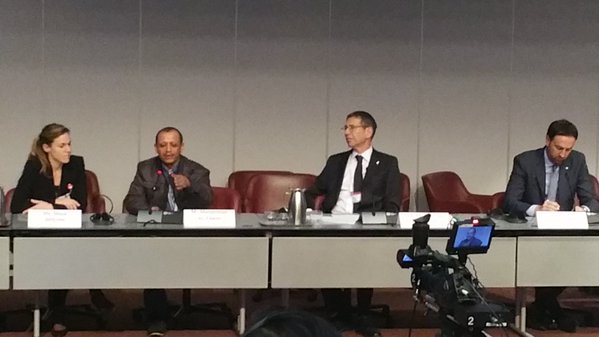On 9 December 2015 in Geneva, at the 32nd International Conference of the Red Cross and Red Crescent, the humanitarian problem of the use of explosive weapons in populated areas was discussed at a side event chaired by Ambassador Thomas Hajnoczi, Permanent Representative of Austria to the UN in Geneva.
Ambassador Hajnoczi noted that explosive weapons are a major cause of death, injury and displacement during war, with civilians making up 90% of casualties from the use of explosive weapons in populated areas. He discussed the severe short and long term humanitarian impacts of the use of explosive weapons in populated areas, particularly those with wide area effects, making a compelling case for the avoidance of their use. Damage to housing and essential infrastructure by explosive weapons has knock on effects for health, livelihoods, and post-conflict reconstruction. Damage to water and sanitation systems can increase the spread of disease, the destruction of schools or fear of attacks can disrupt children’s education, and explosive remnants of war can kill and injure civilians and disrupt economic activity long after conflicts are over.

Mohammed Hassan Mohammed Al Fakih, Programme Coordinator of the Yemeni Red Crescent Society, speaking at the event (Thomas Zehetner/Twitter)
Mohammed Hassan Mohammed Al Fakih, Programme Coordinator of the Yemeni Red Crescent Society, spoke powerfully about the devastating impact of the use of explosive weapons in populated areas in his country, including the physical and psychological toll on himself and his colleagues. Drawing attention to the fact that Yemen is “the worst country in the world for civilian deaths and injuries from explosive weapons”, he spoke of how the Society had lost a volunteer each month in 2015 due to explosive weapon use. He spoke of being unable to help affected colleagues because of a lack of supplies, and the fear felt by the team whenever planes passed overhead.
Michael Talhami, Regional Water & Habitat Advisor (Near and Middle East) of the International Committee of the Red Cross (ICRC), spoke about the long-term impacts of the use of explosive weapons in populated areas, in particular regarding infrastructure damage. He described how the destruction of critical infrastructure by explosive weapons can trigger the collapse and failure of other vital services, thus having ‘domino’ or network effects. This is illustrated in an animated infographic produced by the ICRC:
Maya Brehm of Article 36 and INEW highlighted how civilians are put at a very high risk of harm by the use of explosive weapons in populated areas, even where they are not the target of an attack. She emphasised the particular risks to civilians from the use of explosive weapons with wide area effects in populated areas. Wide area effects may be due to a large blast or fragmentation radius, the dispersal of multiple explosive munitions over an area, relatively inaccurate delivery, or a combination of these factors.
She discussed the significant likelihood of incriminate effects from the use of explosive weapons with wide area effects in populated areas, noting that the ICRC has concluded that “explosive weapons with a wide impact area should not be used in densely populated areas due to the significant likelihood of indiscriminate effects”, and that the UN Secretary-General has repeatedly called on “parties to conflict to refrain from using explosive weapons with a wide-area impact in densely populated areas,” recommending in his latest report on the protection of civilians in armed conflict that UN member states should make a commitment to this effect.
INEW calls on states to join work on a political commitment to stop the use of wide area effect explosive weapons in populated areas, setting standards against which practice could be judged and actions that states could take. More than fifty states have now recognised the humanitarian harm caused by explosive weapons, and states have already expressed support for such a process.
At the event, the critical role that members of the Red Cross and Red Crescent Movement could play to raise awareness and gather information on the impact of explosive weapons was highlighted.
In the opening session of the Conference, ICRC President Peter Maurer called on states to “avoid using explosive weapons in populated areas.”
Austria made a pledge to the Conference, their progress on which will be measured at the next Conference of the movement, to “raise international awareness about the challenge for the protection of civilians in armed conflict posed by the use of explosive weapons in populated areas” and “to look for effective measures to strengthen the respect for international humanitarian law in this regard”.
